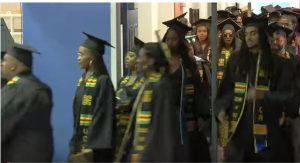
Civil rights leaders once dreamed of a day when Americans would be judged by the content of their character, not the color of their skin, but today a different message is being spread at the University of Texas and other college campuses. “Diversity” means singling out certain races for special treatment.
UT’s extensive diversity bureaucracy effectively creates a separate education experience for “students of color,” with programs like the African American Male Research Initiative, the Black Student Leadership Institute, the Black Male Education Research Collection, the John L. Warfield Center for African and African American Studies, and the African & African Diaspora Studies Department.
UT even has a taxpayer-funded research center, the innocuously-named Institute for Urban Policy Research & Analysis (IUPRA), that is focused on “social issues affecting Black communities in Texas.” Led by Kevin Cokley, IUPRA is listed as a branch of the Black Studies program at UT.
Related: The Growing Threat of Repressive Social Justice
Higher education, integrated even in the Jim Crow south with the support of federal troops in 1963, is returning to racial separation. Some colleges have separate dorms—designated “safe spaces”—for black students. At the University of Texas–which the Supreme Court forced to desegregate in 1950, prior to Brown—colorblindness is being replaced with racial division. The mind-bending irony is that this return to the odious color line is being led by African-American students and academics in the name of diversity!
In the interest of promoting solidarity, UT offers black students a separate lounge area on campus in which to congregate, study, and socialize. The lounge, which serves as a hub for UT’s black community, is, appropriately, named after black separatist Malcolm X. UT’s Multicultural Engagement Center, a student resource office within the Division of Diversity and Community Engagement, hosts a number of black-only events, including a separate graduation ceremony (dubbed Black Graduation), described as “an annual program that gives graduates the chance to commemorate and cherish all the accomplishments, memories, and challenges throughout their college years. Furthermore, it is an occasion for parents and families of graduates to meet with Black faculty and staff to gain a greater insight on the journey of their students.”

The MEC was founded in 1988 in response to the anti-apartheid movement at UT. To protest South Africa’s discriminatory racial policies, black students at UT incongruously insisted on their own center to “centralize academic, social and financial information for African American and Hispanic students.” Promoting diversity, it turns out, requires treating students differently on the basis of race and ethnicity: “The MEC continues to serve as a resource for students of color at The University of Texas at Austin as well as empowers them to be the agents of social change.”
Related: A Professor at Brown Uncovers a Transgender Inconvenient Truth
UT’s extensive diversity bureaucracy effectively creates a separate education experience for “students of color,” with programs like the African American Male Research Initiative, the Black Student Leadership Institute, the Black Male Education Research Collection, the John L. Warfield Center for African and African American Studies, and the African & African Diaspora Studies Department.
UT even has a taxpayer-funded research center, the innocuously-named Institute for Urban Policy Research & Analysis (IUPRA), that is focused on “social issues affecting Black communities in Texas.” Led by Kevin Cokley, IUPRA is listed as a branch of the Black Studies program at UT.
IUPRA describes its analytic approach as “a racial equity framework.” But in reality, it promotes critical race theory — a highly-controversial post-modern movement premised on the existence of institutional racism, the systemic marginalization of people of color, and white power structures within society oppress racial minorities. “White privilege” is a familiar CRT slogan. Edmund T. Gordon, founding chair of UT’s African and African Diaspora Studies Department and UT’s newly-appointed Vice Provost for Diversity, is a proponent of this radical ideology. Gordon risibly believes that the iconic UT fight song, “The Eyes of Texas,” is racist and has argued that race-neutral college admissions at UT would perpetuate America’s legacy of racism and “white supremacist ideologies.”
Accordingly, the research and publications of the IUPRA more closely resemble tendentious, racially-tinged polemics than academic scholarship. IUPRA’s signature initiative, “The State of Black Lives in Texas,” is focused on “racial disparities affecting the Black population in Texas.” One of the components of the initiative is a discussion series called Black Policy and Tea Events. IUPRA professes to be a “nonpartisan organization,” but its progressive staffing and single-minded focus on race yield the typical “social justice” policy agenda. Texas taxpayers are forced to subsidize a stream of op-eds written by IUPRA staffers attacking federal and the state Republican elected officials, and advocating unconstitutional restrictions of so-called “hate speech.”
Related: Diversity Studies–Your Path to a Six-Figure Salary
No matter what the issue—housing, education, health, criminal justice, the discipline of disruptive students in public school, economic inequality—IUPRA’s research invariably concludes that the “problem” is the same: institutional racism. And IUPRA’s “solutions” are equally predictable: racial quotas to ensure equal outcomes in all areas of life. Of course, quotas cannot be maintained without the government constantly counting on the basis of race and intervening to “correct” results that do not match the desired ethnic and racial mix. The propagation of race consciousness—the antithesis of our national motto, E Pluribus Unum—is a central tenet of identity politics.

All this race-based social engineering is sadly reminiscent of the pre-Brown era of “separate but equal.” One IUPRA associate conceded that this is the goal, urging “Let the lofty ideal of integration go,” in favor of “elective separation.” Brown was a failed “experiment,” many CRT proponents believe because integration has doomed black students to “white supremacist and anti-black educational systems and structures.”
In the lobby of UT’s law school hangs a portrait of Heman Sweatt, the African-American plaintiff who broke the color barrier at UT in 1950 by forcing the school to admit blacks. The portrait represents UT’s contrition for a legacy of discrimination that ended nearly 70 years ago. At the unveiling ceremony for the portrait, UT President Greg Fenves movingly recounted that Sweatt “challenged the greatest injustice in the history of UT, and pushed this university to truly become a university of the first-class, for all Texans.” How tragic—and profoundly misguided—that, in the name of “diversity,” leftist academics repudiate the ideal of equality and urge a return to the color line.
Image: Black Graduation Ceremony at Harvard – 2018.
Institutional anti-black racism has been replaced by institutional anti-white racism. Racists will always be with us – only the target races change.
Good job drinking from the firehouse of contemporary racism, clarissa. The old south lost its lunch-counter separation through civil rights awareness, but you’re helping them get their segregation back. brought to you by the same party that went to war to defend slavery, and repackaged as something for your own good. Well played!
@clarissa White people also have obstacles placed in their way during college. Should we have a White Grad?
To Clarissa Townes:
So your view is that “racism is bad” but “reverse racism is good.” And that racial segregation is bad, except when it provides non-whites with special benefits. Further, that color-blind concepts like “merit” and “achievement” are white supremacist dog whistles. So you think we should just disregard old fashioned ideas, such as that individuals should be treated according to their character, actions, and achievements, and replace it with treatment according to racial category. Some places made that state policy in the 20th century. And you want to emulate that?
So much for assimilation. And equal opportunity. Graduate with debt, but not an education useful in the work world.
Note the “common cause” knitting draped over the ladies’ shoulders. You have your faux African jazz along with LGBTQ “solidarity. jazz” Tres amusant. It is part and parcel of the mascot movement in which followers place themselves in the Left’s palm without realizing how ludicrous it is for black feminists to make common cause with Muslims – even those who practice female genital mutilation. Sowell says it well: “Many white liberals have adopted blacks as mascots, in order to ‘make a statement’ against American society. But mascots are only symbols, and their well-being is seldom a top priority.” – Thomas Sowell
In other words, in western-technology civilization, some people can’t compete academically, so rather than hurt anyone’s feelings we all have to pretend that unequal abilities are somehow still equal. It’s that simple, isn’t it?
Ha! the Marxist racial explotation logic of Clarissa Townes, what she would think of NAAWP or other for other colors: yellow , green(Martian) “people”… but no the political, financial racket is only “black” people. For now.
Hey we could also have organizations for lower than median height people, higher than median height people, social awkward people, ugly(or should i say not mainstream beauty people) , premature bald people, etc, etc …
It’s great that Blacks are making Segregation acceptable again. Fantastic!
Clarissa, the problem is that your arguments were the exact same arguments made by the white men of the 1950’s and 1960’s: Keep the races apart, let the races decide what is best for themselves. Those arguments were wrong then, and they are wrong now.
Grouping people by hair type or skin color or other immutable characteristic isn’t the same as grouping people by major. At all.
In 1958, there were no Black students in the graduating class of UT. Black Grad was created in 1995 in response to the various and continuous racial incidents still occurring on campus. It was and continues to be a celebratory event that makes the statement that in spite of folks that think like you and the obstacles placed in the path of Black students, they are still graduating from this university. I would encourage you to actually attend a graduation and get your facts straight. They are not separate, they are in conjunction. But let me blow your mind real quick: there is also a Latinx Grad, Lavender Grad as well as Departments of History, Psychology, and Wnglish Hraduation Ceremonies. Why not just have one big one: amirite? I could speak of the other nonsense that you wrote about, but have neither the energy nor the desire. Stay in your bubble, it’s safe in there.
Bullshit. They’re segregating. On purpose. And so are all the other groups based on race you mentioned.
Discrimination based on skin color/ethnicity is racism. Straight up. No acceptions. And if you think that acceptions are allowed, we can certainly create white only bathrooms, businesses and schools. What’s good for the f*cking goose….
“I have sort of brownish hair and blue eyes. Is there a graduate ceremony just for me?”
This concept of racially-based graduation ceremony (or anything similar) is definitively racist. But it’s also stupid, unsophisticated, and could only appeal to an uneducated narcissist in the first place. I’ll keep that in mind the next time someone tells me they graduated from UT or I see it on a resume.
So Clarissa:
What you’re saying is that the residual racism of 1995 drove you to resegregate. It’s funny racism was the cause of Jim Crow segregation. But the differences : were 1. Crow was run by the government and was brutal while today the government discriminates in your favor and 2: Back then truly courageous black men and women fought to take their rightful place in society while you, facing one one hundredth of the racism they did flee like cowards back into segregation. “People are me to me”.
And I hate to break it to you but college is the bubble, particularly in a race segregated safe place. The real world has no use for people who can’t cope with people different than them.
You just proved his point. You aren’t celebrating diversity, you’re celebrating identity and encouraging segregation when you do.
The fact that there is a Latinx and Lavender Grad simply serves to further make Mark Pullian’s point and that this foolishness extends well beyond black, but rather is a much broader progressive objective.
Ah yes, affirmative action hard at work.
Lol
Sorry, Clarissa, the problem is that black students are not getting the same education, not held to the same standards and are being fed a steady diet of victimization in the place of knowledge and wisdom. If I were you, I would be furious with this “soft bigotry” that states that black students can’t succeed without a special curriculum. (And, I am not you and am furious.) I don’t accept that. Obviously you do accept that, based on your reply.
I am a white male over 80 years old. I’ve seen enough to know that encouraging or forcing racial or ethnic segregation is a very bad idea. If I were a white student on the UT campus, I would simply go along with what the diversity-screamers want. Why should I make any effort at contact with such people?
I was also a corporate department manager years ago, when there weren’t Women’s Studies or Black Studies or similar majors in college. I can assure you that any resume from a person with such a major would be instantly trashed, as it would indicate someone with a biased political agenda rather than an intellectual one.